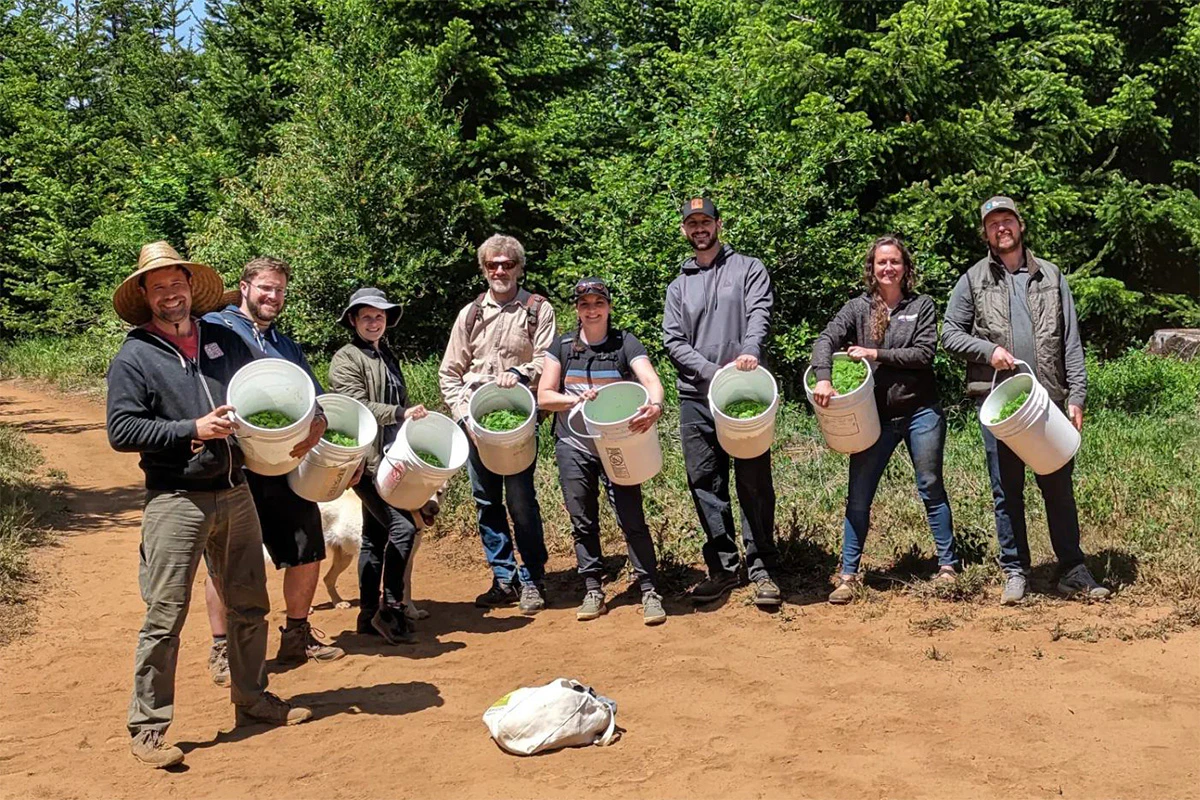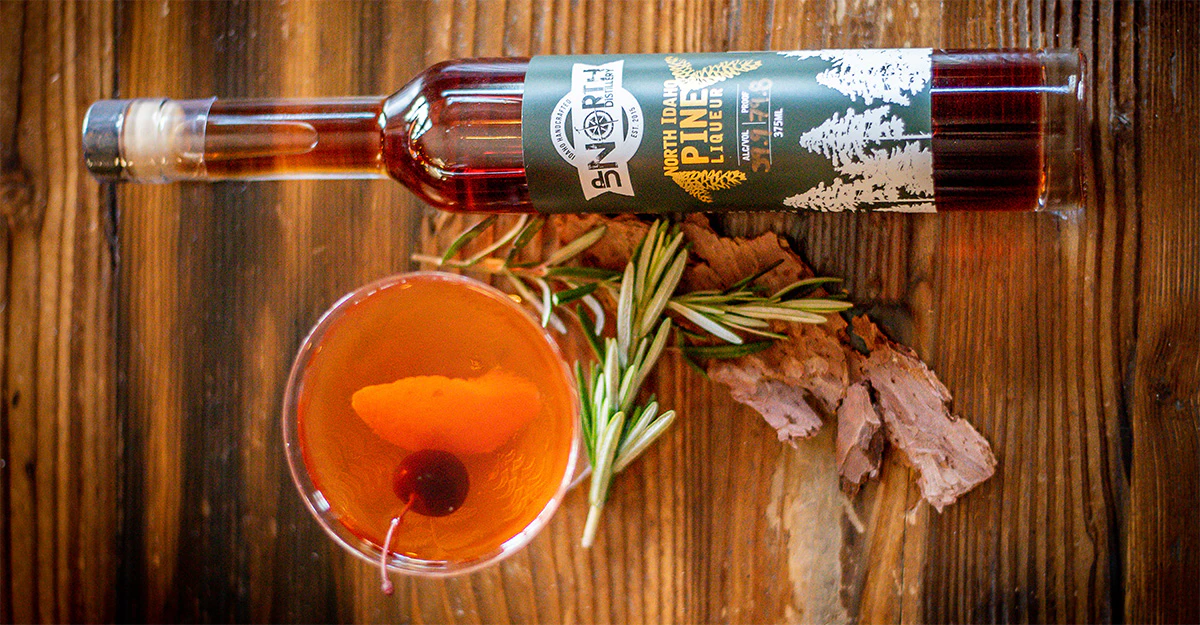If there’s a thing that grows on Earth and offers sugar or interesting flavor, distillers have at least given it a try. Many such things come from trees, including all sorts of fruits and the juniper that’s so important to gin.
We’ve covered distilling from tree sap, but there’s another overlooked element that can make for beautiful spirits and liqueurs: the fruit and buds of pine trees. The tradition of turning pine fruit into alcohol stretches at least as far back as the late 18th century, centered in the region surrounding the Alps.
Pining for Local Flavor
Zirbenschnaps is the name for the neutral distillate and the pine fruit that macerates in it; zirben specifically refers to the Arolla pine—also known as Austrian, Swiss, or stone pine. Schnaps, of course, is German word for a strong spirit. Zirbenz Stone Pine Liqueur of the Alps has been made since 1797 and was first imported to the United States in 2005, and since then it’s struck a chord among many bartenders. Pine flavors are especially popular in today’s more bitter, herbaceous cocktails, resonating with fans of amari and other bitters.
So far, not many North American distillers are making their own pine-based spirits, but there are notable offerings among those who do. Current cocktail trends and demand from bars could be enough motivation for a small distillery to try it, but there’s another factor driving producers such as Oregon’s Clear Creek or Idaho’s Up North: the ability to craft a traditional European spirit with local ingredients.
Steve McCarthy founded Clear Creek in 1985. The brand’s master distiller, Caitlin Bartlemay, says McCarthy had fallen in love with European pear brandy and wanted to learn how to make it. Clear Creek went on to build a portfolio of well-known European-style spirits, grounded in Pacific Northwest terroir. McCarthy retired in 2014, and Hood River Distillers bought Clear Creek, but Bartlemay—who worked with McCarthy before his retirement—says the distillery’s ethos remains the same.
“Clear Creek is a creative sandbox,” she says. “We’re always looking to see what grows in our own backyard and what we can make with it.”
In that region, Douglas fir trees grow in abundance, and McCarthy sought a way to tie them to European brandy. Technically, Bartlemay says, Clear Creek Douglas Fir Brandy is a geist—a German type of liquor made by macerating unfermented fruit in neutral spirit, then redistilling it. There is something of a hurdle already, she says, in getting people to understand that brandy can be beautifully agricultural, rather than “a dust-covered bottle that tastes like the inside of your grandmother’s handbag.” The Douglas Fir Brandy is a true eau de vie, made in the tradition of European brandy and zirbenschnaps, but celebrating the fruit of Pacific Northwest trees.
The origin story of Up North’s North Idaho Pine Liqueur isn’t all that different. Co-owner Randy Mann was at a restaurant owned by family friends. When one of those friends heard about Mann’s distillery, he brought out the zirbenschnaps he’d recently brought home from Austria. Mann began wondering how he could re-create it using Idaho terroir.
Idaho’s state tree is the Western white pine. “Species of pine trees are so close, there are barely any real differences,” Mann says, noting the similarities between Idaho’s pines and the Arolla pines that go into zirbenschnaps. To strengthen North Idaho Pine Liqueur’s local focus, Mann uses a neutral spirit made from northwest Idaho apples—zirbenschnaps normally gets a corn-based spirit—as well as honey from southeast Idaho as sweetener.
Sourcing the Fruit of the Pines
The parts of the tree that typically go into pine spirits are either the buds, which eventually grow into needles, or the fruit, which eventually grows into pinecones.
Mann opts for the fruit, explaining that it “starts out as a tassel on the tree, then matures into this gooey, sappy green pinecone, then a gooey, purple pinecone dripping with sap—and those are the ones I want.” Timing is everything when you’re working with an ingredient that changes by the day; the window to pick them in that “gooey, purple” stage is narrow.
Sourcing is a challenge. Both Clear Creek and Up North head out and climb trees themselves to gather what they need. Foraging is a novel part of their process, and not every distiller is so adventurous. Those who’d prefer not to head into the forest themselves should be able to identify local suppliers.
Mann says the immature cones grow about five feet (1.5 meters) below the treetops—which can be 30 to 50 feet (nine to 15 meters) high—and on down from there. He climbs every tree himself. “I can’t rent someone’s bucket truck and get it covered in sap and deal with a terrible cleaning fee,” he says. He heads into the forest, picks as many cones as he can, brings them back to the distillery, and immediately puts them into the apple brandy to begin maceration. He says he might do this for a few days in a row, heading back out to pick more cones and continuing to add them to the 200-gallon tank. He doesn’t measure out any cone-to-brandy ratio, he says; he just keeps picking until he thinks he has enough.

The Clear Creek/Hood River teams on harvest day. Photo: Courtesy Hood River Distilleries.
For Clear Creek, it’s the buds rather than the fruit, and the Clear Creek team also harvests their own buds. Bartlemay says the field trip is invigorating, and the whole team looks forward to it. They also take the responsibility of directly sourcing from nature seriously, ensuring that they don’t over pick or damage trees. They work with the Hood River Forest Service and pay them a foraging fee; the service then provides a map of where they’d like the Clear Creek team to pick. They pick only the new, bright green growth. They don’t pick from trees shorter than 10 feet, and they don’t use ladders.
“We have a four- to five-day window to harvest these buds,” Bartlemay says. “We want to get the material off while the bud … is lined in this chartreuse color. As the bud gets longer and starts turning into the tree, it turns tan and brown, and the flavor profile changes immensely.”
When it’s hot, this process can happen more quickly; when it’s cooler, there’s a bit more picking time. Bartlemay describes the flavor they get from these delicately timed buds as having lots of light green and citrus notes, alongside the quintessential Douglas fir pine and sap qualities. Clear Creek sends a four-person team to pick 100 pounds (45 kilos) of buds each year—Bartlemay says they would never make so much of the brandy that it becomes detrimental to the area’s trees—and it takes four or five days to gather that much.
They immediately take those buds back to the distillery and pitch them right into Clear Creek’s spirit, which for this recipe is a mixture of brandies—mostly grape-based, with a small amount of pear.
Pine Macerations
The urgency of getting those buds into the brandy as quickly as possible is no small consideration: If they’re not used immediately, the buds start to oxidize. “The results would be disastrous if we even held them overnight,” Bartlemay says.
In stainless-steel tanks, the buds macerate in the pear-grape brandy for six months to a year, then that spirit is re-distilled. When the team is picking buds for a new batch, they also add some fresh ones to the previous year’s batch or re-distilled brandy—the geist, technically—for color. All of the Douglas Fir Brandy’s color comes from the buds’ chlorophyll. Bartlemay says they then proof the brandy down to 47.73 percent ABV using glacier spring water. They hold onto each batch until Hood River needs more supply, then the brandy goes to the parent company for bottling.
The immediacy of the tree’s fruit getting right into the brandy is the same at Up North. Beyond that, Mann says he tends to tinker with each batch, landing on whatever ratio of fruit-to-spirit tastes the best. That’s also what guides the length of the maceration period—it stops when he finds that the spirit is no longer extracting flavors from the fruit—and that tends to take about four months.
After macerating and adding the honey for a touch of sweetness, Mann says he must face “the mess of filtration”—another challenge of distilling from fresh tree products.
“I just have to spend a lot of money on filters,” he says. “When I drain the initial tank, I can’t pump it; I have to do everything by gravity; otherwise it just plugs everything up. I lift the tank with a forklift and filter it through a regular kitchen strainer three times. The fourth time, I put paper towels in the strainer to get more solids out.” Mann says he’s gone through as many as three filters in one bottling, and it can be a week-long process just to bottle the pine liqueur. “But it’s the most fun thing I make,” he says. “I just enjoy the process so much.”

Photo: Courtesy Up North Distillery.
Passion drives the production of Up North’s liqueur and Clear Creek’s pine brandy. Sourcing and filtering can be challenging, but foraging can make for a fun day at work, and the payoff is a unique product that’s still rare in North America. Pine spirits also give distillers a chance to immerse themselves in a European tradition while directly showcasing local trees.
Meanwhile, the hurdle of consumer education is one that will inevitably lead to greater public familiarity and interest in a distinctive spirit made with local flavor.
